Madurai, Minakshi Sundareshvara Temple
Historical background
Murals in the Kilikottu mandapa and on the north side of the Potramarai tank.
Read more
On the west side of the ‘Golden Lily’ tank in the Minakshi Sundareshvara temple in Madurai a small pavilion projects outwards from the colonnade skirting the tank. Laid out on its ceiling is a painting, c. 1700, depicting the wedding of the goddess Minakshi, a form of Parvati, to Shiva in his aspect as Sundareshvara or Sundarar, the ‘Beautiful Lord’, an event of pivotal importance in the history of the town.
The central tableau is framed by vignettes, illustrating the story of Tatatakai (as Minakshi was known before her wedding). She was a Pandyan queen-warrior, the only child of a Pandyan king. Born with three breasts from the sacrificial fire, a prophecy foretold that her third breast would disappear when she met her husband. On her father’s demise, she set out to conquer the eight directions of space and eventually reached Mount Kailasa. Once there, she was met by Shiva, whereupon her third breast disappeared. She paid obeisance to Shiva and he agreed to marry her. The couple were wed with great pomp in Madurai at the presence of a number of deities and celestials.
Interestingly, the painting does not depict only divine figures, but also three historic figures: on the right are Queen Mangammal, who ruled from 1690, and her grandson Chokkanatha who succeeded her in 1706; on the left is Ramappaiya dalavay (general or minister). The three of them are identified by bilingual inscriptions in Tamil and Telugu. Queen Mangammal, appears once again in one of the vignettes around the central composition. Here the goddess is passing the chenkol (sceptre) to her via a priest, thus stressing the relationship between the deity and the ruler, as well as the importance of Minakshi, the queen of Madurai.
The feats of Minakshi and Sundareshvara in Madurai are described in detail in the Tiruvilayadal Puranam, ‘The Story of the Sacred Games’, a text which, although composed in the early to mid-17th century, develops some themes traceable to the 5th century. A set of murals, dated 1894 and painted over in the 1950s, depicting the whole work decorated part of the colonnade skirting the Golden Lily tank. Copies of these are now in the temple’s Thousand Pillared Hall. In the late 1990s a new series was commissioned to T. Vinoth, an artist working in the Kerala style. Unfortunately, however, this new set was never completed.
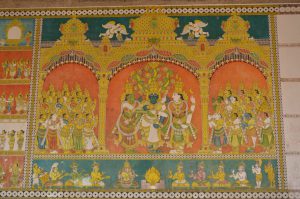
Date: Late 1990s; unfinished; Artist, T. Vinoth
Description: The marriage of Minakshi and Sundareshvara. Vishnu, on the left, gives the bride away. (TP 5)
Location: Tamil Nadu Temple;Minakshi Sundareshvara Temple;Madurai
Positioning: Potramarai tank, north side
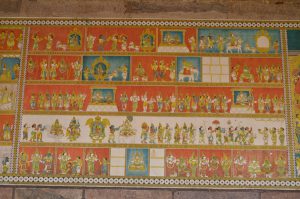
Date: Late 1990s incomplete; Artist, T. Vinoth
Description: Tatatakai fights against a gana; She fights against Shiva’s army; Nandi reports to Shiva; Shiva himself enters the battlefield; Tatatakai’s third breast disappears; She is defeated; Shiva tells her to return to Madurai where their wedding will be celebrated.(TP 5)
Location: Tamil Nadu Temple;Minakshi Sundareshvara Temple;Madurai
Positioning: Potramarai tank, north side
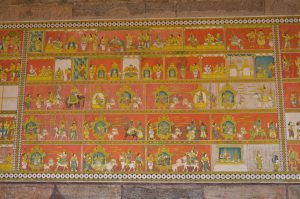
Date: Late 1990s; Artist, T. Vinoth
Description: Narrative of the previous birth of Tatatakai (TP 4); Tatatakai sets out to conquer the world and marches up to Kailasa. (TP 5)
Location: Tamil Nadu Temple;Minakshi Sundareshvara Temple;Madurai
Positioning: Potramarai tank, north side
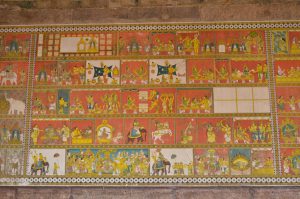
Date: Late 1990s, incomplete; Artist; T. Vinoth
Description: The sacred city of Madurai is built by Kulashekhara Pandya on command of Sundareshvara.(TP 3); Kulashekhara’s son, Malayattuvachan marries the Chola princess Kanchanai; Tatatakai, their daughter is born; She has three breasts; She is trained in the martial arts; She is consecrated queen of Madurai; She performs the last rites for her father. (TP 4)
Location: Tamil Nadu Temple;Minakshi Sundareshvara Temple;Madurai
Positioning: Potramarai tank, north side
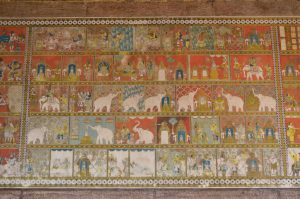
Date: Late 1990s; Artist: T. Vinoth
Description: Messengers of Indra discover the Shivalinga near a lake which Indra calls Potramarai and the worship of Sundarar (Shiva) is established (TP 1); Airavata, Indra’s white elephant is freed from Durvasa’s curse by worshipping the linga (TP 2); The sacred city of Madurai is built by Kulashekhara Pandya on command of Sundareshvara. (TP 3)
Location: Tamil Nadu Temple;Minakshi Sundareshvara Temple;Madurai
Positioning: Potramarai tank, north side
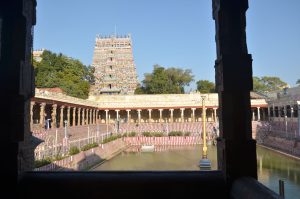
Date: 17th-18th centuries
Description: View of the Chitra gopura and the Potramarai tank from the Kilikuttu mandapa.
Location: Tamil Nadu Temple;Minakshi Sundareshvara Temple;Madurai
Positioning: Potramarai tank
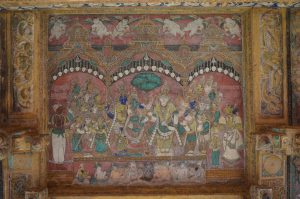
Date: c. 1700
Description: The wedding of Minakshi and Sundareshvara, witnessed by Queen Mangammal, Vijayaranga Chokkanatha (on the right) and the dalavay (minister) Ramappaiya on the left.
Location: Tamil Nadu Temple;Minakshi Sundareshvara Temple;Madurai
Positioning: Kilikuttu mandapa, ceiling
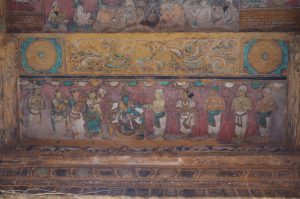
Date: c. 1700
Description: Minakshi entrusts the sceptre to Queen Mangammal via an intermediary priest at the presence of attendants and courtiers.
Location: Tamil Nadu Temple;Minakshi Sundareshvara Temple;Madurai
Positioning: Kilikuttu mandapa, ceiling
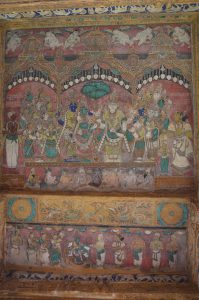
Date: c. 1700
Description: Top: The wedding of Minakshi and Sundareshvara. Bottom: Minakshi gives the sceptre to Queen Mangammal via an intermediary priest at the presence of attendants and courtiers.
Location: Tamil Nadu Temple;Minakshi Sundareshvara Temple;Madurai
Positioning: Kilikuttu mandapa, ceiling
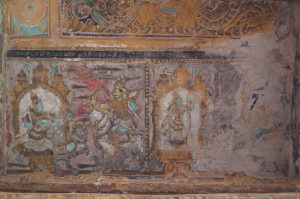
Date: c. 1700
Description: Tatatakai defeats Kubera and Ishana. (TP 5)
Location: Tamil Nadu Temple;Minakshi Sundareshvara Temple;Madurai
Positioning: Kilikuttu mandapa ceiling
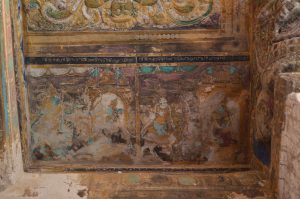
Date: c. 1700
Description: Tatatakai defeats Varuna and Vayu. (TP 5)
Location: Tamil Nadu Temple;Minakshi Sundareshvara Temple;Madurai
Positioning: Kilikuttu mandapa, ceiling
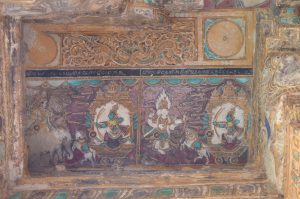
Date: c. 1700
Description: Tatatakai defeats Indra and Agni. (TP 5)
Location: Tamil;Nadu Temple;Minakshi Sundareshvara Temple;Madurai
Positioning: Kilikuttu mandapa,ceiling:
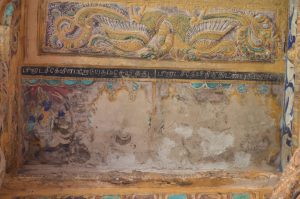
Date: c. 1700
Description: Tatatakai defeats Yama and Nairriti. (TP 5)
Location: Tamil Nadu Temple;Minakshi Sundareshvara Temple;Madurai
Positioning: Kilikuttu mandapa, ceiling